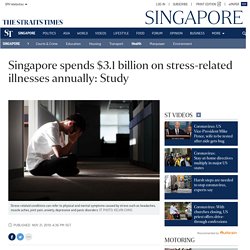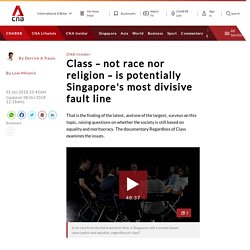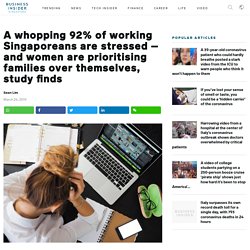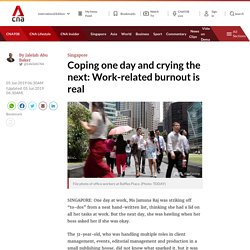

This trend is worrying with additional data indicating that 80 per cent of them had the term "always on" culture for their work (Straits Times, 2019).
The culture described earlier is based on the need to think about their job during and after their working hours. Thus, we will explore two primary factors in the pursuit of social equality that contributes to stress in working adults.
Singapore spends $3.1 billion on stress-related illnesses annually: Study, Health News.
SINGAPORE - A study has found that Singapore spends about US$2.3 billion (S$3.1 billion), or 18 per cent, of its total healthcare expenditure on stress-related illnesses annually.

This put the nation's proportion of expenditure on stress-related illnesses second-highest out of the nine regions studied in the report, coming just 0.8 per cent behind Australia's 18.8 per cent. The other seven regions were Hong Kong, South Korea, Taiwan, Thailand, United Arab Emirates, the United Kingdom and the United States. The report, which was produced by healthcare consultancy firm Asia Care Group on behalf of health insurance and services company Cigna, was published on Thursday (Nov 21). Class – not race nor religion – is potentially Singapore's most divisive fault line. SINGAPORE: The fault lines that have been the most worrisome in Singapore since the nation’s independence are, after 53 years, no longer so in the eyes of its people.

Instead of race and religion, what worries Singaporeans more is the class divide. That is the finding of the latest, and one of the largest, surveys on this topic, which Dr Janil Puthucheary, the chairman of OnePeople.sg – the national body promoting harmony – worked with Channel NewsAsia to commission. Almost half of the 1,036 citizen respondents felt that income inequality is the likeliest to cause a social divide here.
As sociology professor Tan Ern Ser said after examining the data: “What we’re seeing here is that if you compare between race, religion, sexual orientation, nationality (country of birth) and class, class matters.” It matters so much that only about 20 per cent of the respondents felt that race was likeliest to cause a social divide, and an almost similar proportion felt that way about religion. Class – not race nor religion – is potentially Singapore's most divisive fault line. A whopping 92% of working Singaporeans are stressed – and women are prioritising families over themselves, study finds, Business Insider - Business Insider Singapore.
Pexels If you’re feeling stressed at work, you’re not alone.

A vast majority of working Singaporeans are under stress, and women in particular feel that it’s less manageable, a survey has found. In the 2019 Cigna 360 Well-Being Survey, a whopping 92 per cent of working Singaporeans report feeling stressed, higher than the global average of 84 per cent. Of this, 13 per cent say their stress is unmanageable, which is on par with the global average, according to the study which surveyed a total of 13,200 online interviews in 23 markets, including 502 residents in Singapore. And stress doesn’t go undetected in the workplace. Read also: 6 in 10 Singaporeans admit that they don’t leave work on time just to ‘show face’ Noticing colleagues’ stress in turn makes respondents more self-aware, it seems. 30 per cent of respondents feel more conscious about managing their own stress upon seeing others stressed at work. Women prioritise families over themselves Lack of support at work Unprepared for old age.
Coping one day and crying the next: Work-related burnout is real. SINGAPORE: One day at work, Ms Jamuna Raj was striking off “to-dos” from a neat hand-written list, thinking she had a lid on all her tasks at work.

But the next day, she was bawling when her boss asked her if she was okay. The 31-year-old, who was handling multiple roles in client management, events, editorial management and production in a small publishing house, did not know what sparked it, but it was the start of her journey towards realising that she was experiencing burnout. “I was striking the to-dos off, but for every one that I did, there were five more. Still, because I was striking things out, I thought I could handle it,” she told CNA. At the time, she had multiple deadlines looming ahead of her. Her boss had checked on her because she had changed and her colleagues noticed it, said Ms Jamuna, a Singaporean who lives in Melbourne. “As soon as he (her boss) asked me that, I started bawling. READ: Commentary: What’s behind burnout? Untitled.